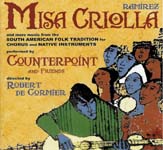This splendidly-performed and -recorded disc offers substantial entertainment and uplift. Ariel Ramirez (b. 1921) spent his 20s traveling widely in his native Argentina, absorbing various elements of folk music, particularly those that related to popular dance forms. He hit big with his 1964 Misa Criolla (Creole Mass, meaning mass in the style of South American cultures that arose in the mixture of Iberian and Indian). This songful choral music, accompanied by upbeat native percussion and some harmony and melody instruments such as harps and guitars, was immediately popular when it appeared on LP in North America and Europe. It wasn’t just the hi-fi friendly percussion that made it popular: the choral writing itself is bright, optimistic, and never stuffy, and there is an attractive, unpretentious spiritual quality.
Ramirez continued to work in this style, immediately capitalizing with Navidad Nuestra (Our Christmas), which became popular in South America. In 1980, in his Misa por la paz y la justicia (Mass for Peace and Justice), he used the same style to protest repression by the Argentine military government. The whole of the first two pieces and four movements of the latter Mass are included here, and the decision to add an assortment of five short folk-derived choral settings was a good one. As it is, a certain sameness prevails when all three Ramirez works are listened to in order. For all the charm of the melodies and the lilt of the accompaniment, the musical substance is not especially deep. Nevertheless, this is not meant as disrespect for the music, as each of these Ramirez pieces is thoroughly entertaining when listened to separately.
Conductor Robert de Cormier and his 16-voice ensemble called Counterpoint (and the additional singers sometimes added to its ranks) produce an ideal sound–folk-like, with sparingly used vibrato, allowing a purity of intonation that prevents congestion and heaviness from setting in. De Cormier’s interpretation is obviously informed by knowledge of the various national dance rhythms that are the basis for Ramirez’s music, yet there is a sense of honest belief and simplicity presented by the singers. The sound is intimate, recorded for the most part in a church in Stowe, Vermont rather than in the more classical confines of the Troy, New York concert hall usually favored by Albany. I recommend the release warmly. [6/30/2005]
































